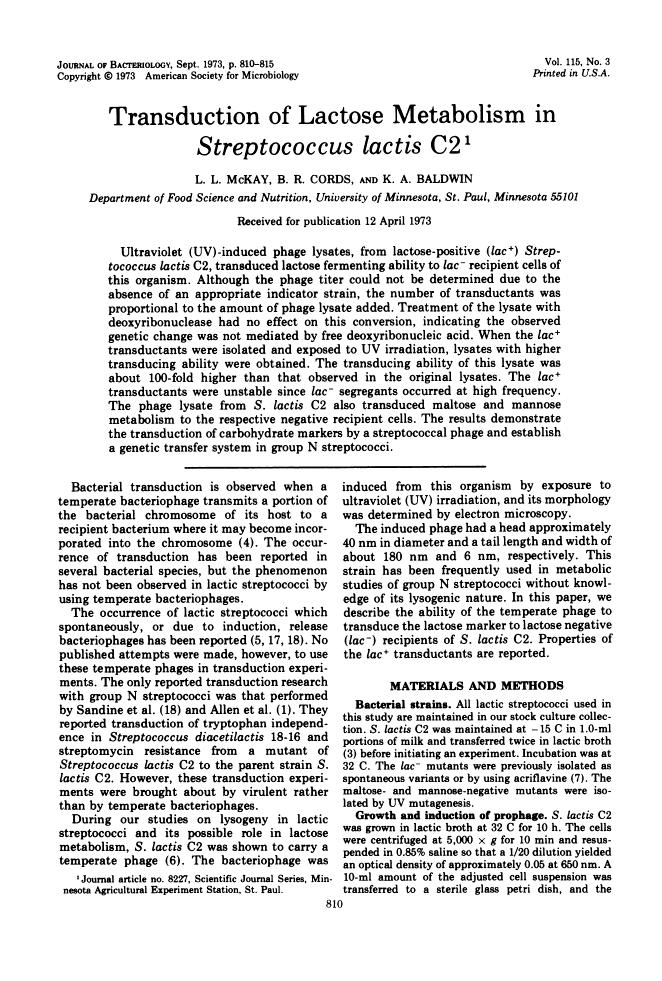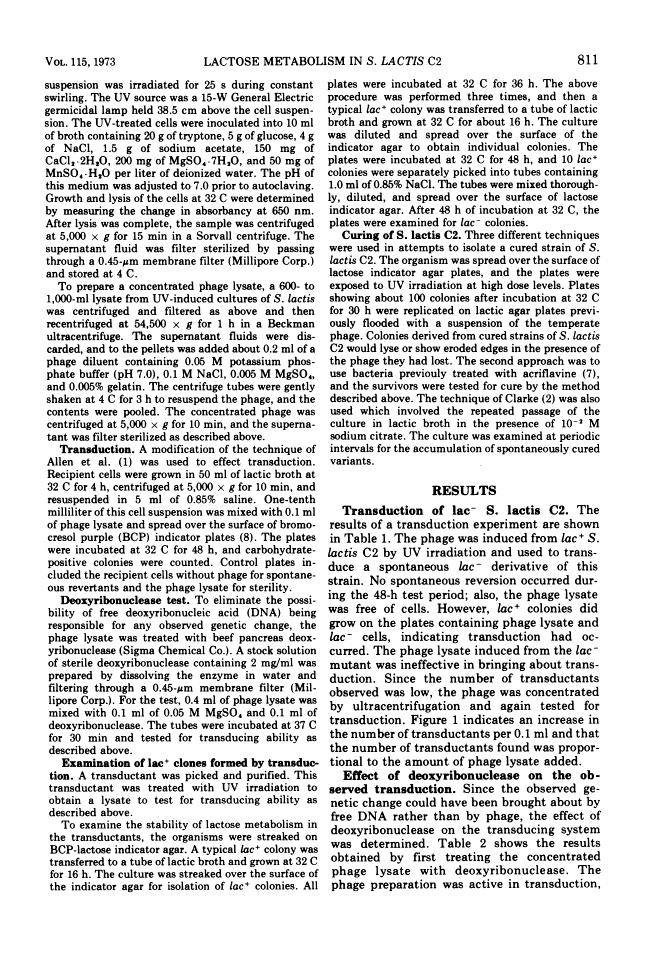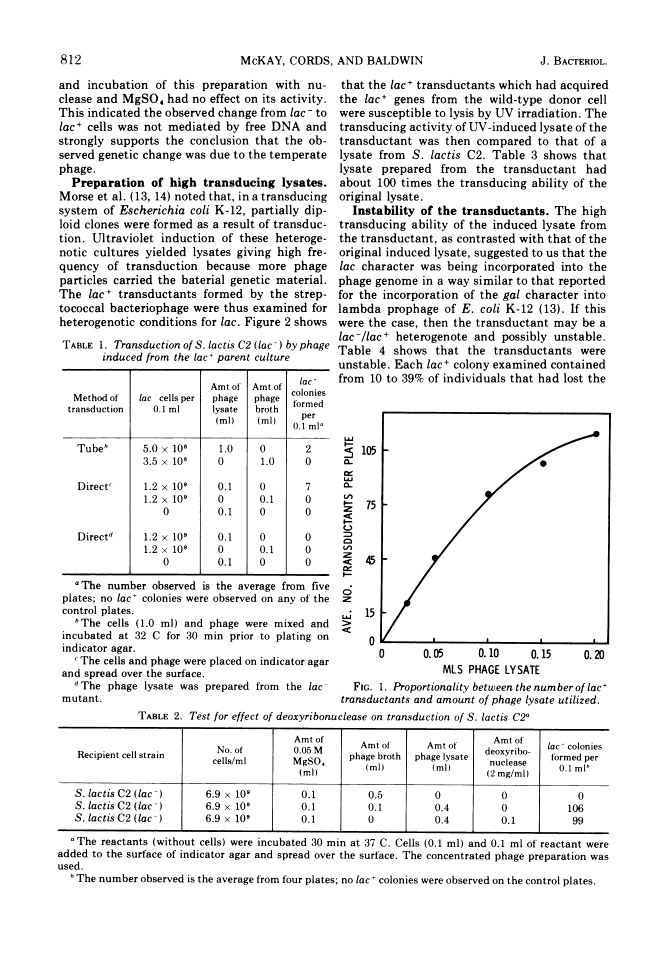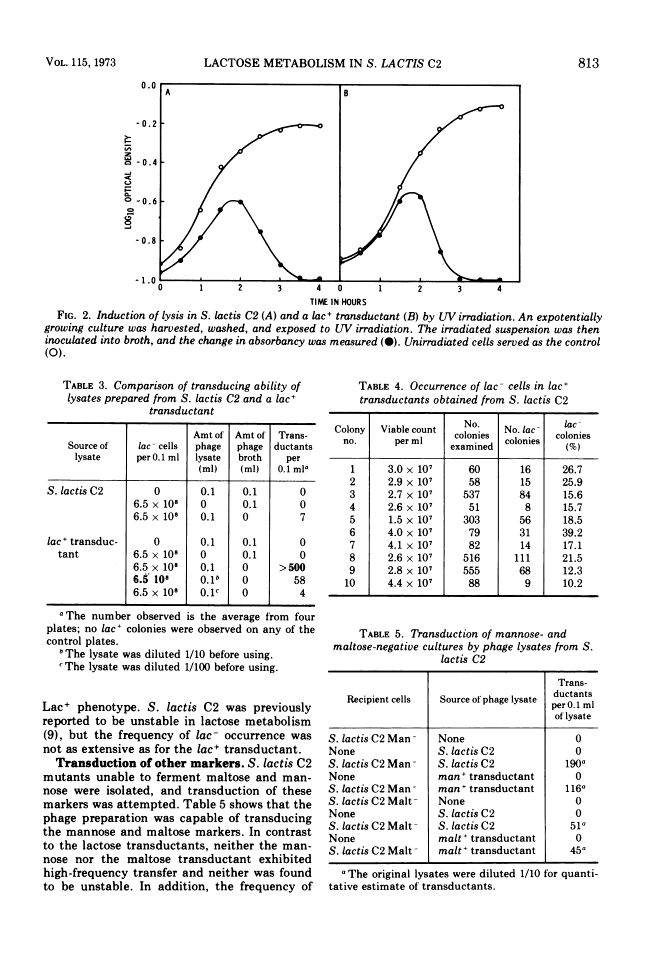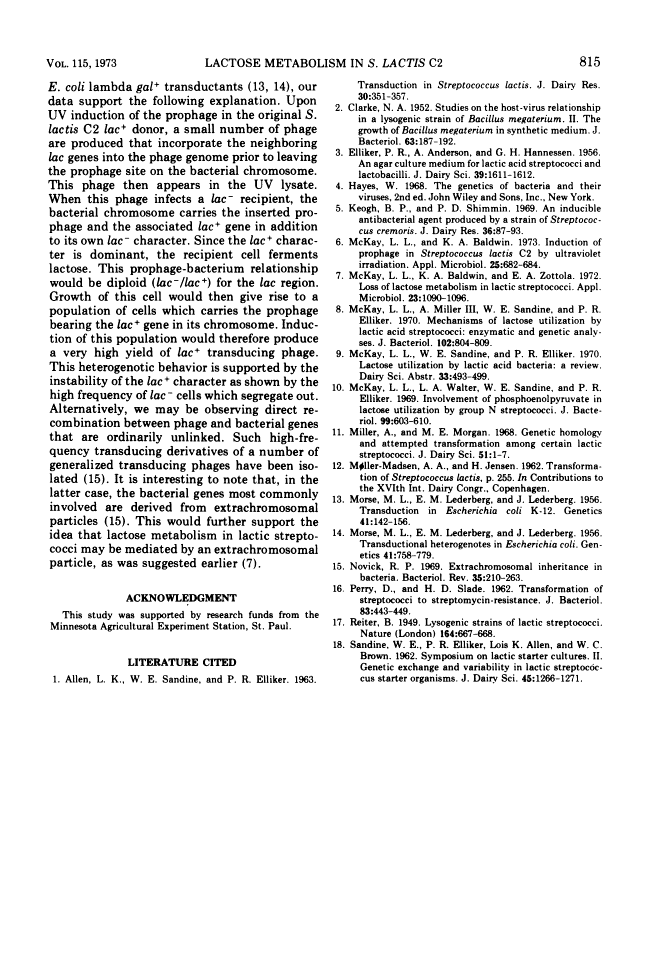Abstract
Free full text

Transduction of Lactose Metabolism in Streptococcus lactis C21
Abstract
Ultraviolet (UV)-induced phage lysates, from lactose-positive (lac+) Streptococcus lactis C2, transduced lactose fermenting ability to lac− recipient cells of this organism. Although the phage titer could not be determined due to the absence of an appropriate indicator strain, the number of transductants was proportional to the amount of phage lysate added. Treatment of the lysate with deoxyribonuclease had no effect on this conversion, indicating the observed genetic change was not mediated by free deoxyribonucleic acid. When the lac+ transductants were isolated and exposed to UV irradiation, lysates with higher transducing ability were obtained. The transducing ability of this lysate was about 100-fold higher than that observed in the original lysates. The lac+ transductants were unstable since lac− segregants occurred at high frequency. The phage lysate from S. lactis C2 also transduced maltose and mannose metabolism to the respective negative recipient cells. The results demonstrate the transduction of carbohydrate markers by a streptococcal phage and establish a genetic transfer system in group N streptococci.
Full text
Full text is available as a scanned copy of the original print version. Get a printable copy (PDF file) of the complete article (891K), or click on a page image below to browse page by page. Links to PubMed are also available for Selected References.
Selected References
These references are in PubMed. This may not be the complete list of references from this article.
- CLARKE NA. Studies on the host-virus relationship in a lysogenic strain of Bacillus megaterium. II. The growth of Bacillus megaterium in Synthetic medium. J Bacteriol. 1952 Feb;63(2):187–192. [Europe PMC free article] [Abstract] [Google Scholar]
- McKay LL, Baldwin KA. Induction of prophage in Streptococcus lactis C2 by ultraviolet irradiation. Appl Microbiol. 1973 Apr;25(4):682–684. [Europe PMC free article] [Abstract] [Google Scholar]
- McKay LL, Baldwin KA, Zottola EA. Loss of lactose metabolism in lactic streptococci. Appl Microbiol. 1972 Jun;23(6):1090–1096. [Europe PMC free article] [Abstract] [Google Scholar]
- McKay L, Miller A, 3rd, Sandine WE, Elliker PR. Mechanisms of lactose utilization by lactic acid streptococci: enzymatic and genetic analyses. J Bacteriol. 1970 Jun;102(3):804–809. [Europe PMC free article] [Abstract] [Google Scholar]
- McKay LL, Walter LA, Sandine WE, Elliker PR. Involvement of phosphoenolpyruvate in lactose utilization by group N streptococci. J Bacteriol. 1969 Aug;99(2):603–610. [Europe PMC free article] [Abstract] [Google Scholar]
- Morse ML, Lederberg EM, Lederberg J. Transduction in Escherichia Coli K-12. Genetics. 1956 Jan;41(1):142–156. [Europe PMC free article] [Abstract] [Google Scholar]
- Morse ML, Lederberg EM, Lederberg J. Transductional Heterogenotes in Escherichia Coli. Genetics. 1956 Sep;41(5):758–779. [Europe PMC free article] [Abstract] [Google Scholar]
- Novick RP. Extrachromosomal inheritance in bacteria. Bacteriol Rev. 1969 Jun;33(2):210–263. [Europe PMC free article] [Abstract] [Google Scholar]
- PERRY D, SLADE HD. Transformation of streptococci to streptomycin resistance. J Bacteriol. 1962 Mar;83:443–449. [Europe PMC free article] [Abstract] [Google Scholar]
Associated Data
Articles from Journal of Bacteriology are provided here courtesy of American Society for Microbiology (ASM)
Full text links
Read article at publisher's site: https://doi.org/10.1128/jb.115.3.810-815.1973
Read article for free, from open access legal sources, via Unpaywall:
https://jb.asm.org/content/jb/115/3/810.full.pdf
Free to read at jb.asm.org
http://jb.asm.org/cgi/content/abstract/115/3/810
Free after 4 months at jb.asm.org
http://jb.asm.org/cgi/reprint/115/3/810
Citations & impact
Impact metrics
Citations of article over time
Article citations
Employing lytic phage-mediated horizontal gene transfer in Lactococcus lactis.
PLoS One, 15(9):e0238988, 14 Sep 2020
Cited by: 2 articles | PMID: 32925946 | PMCID: PMC7489543
An amazing journey.
Annu Rev Food Sci Technol, 6:1-17, 04 Feb 2015
Cited by: 2 articles | PMID: 25665173
Review
Back to nature: a revival of natural strain improvement methodologies.
Microb Biotechnol, 8(1):17-18, 09 Dec 2014
Cited by: 4 articles | PMID: 25488414 | PMCID: PMC4321361
Molecular characterization and structural instability of the industrially important composite metabolic plasmid pLP712.
Microbiology (Reading), 158(pt 12):2936-2945, 28 Sep 2012
Cited by: 28 articles | PMID: 23023974
Development and characterization of lactose-positive pediococcus species for milk fermentation.
Appl Environ Microbiol, 62(3):936-941, 01 Mar 1996
Cited by: 24 articles | PMID: 16535280 | PMCID: PMC1388805
Go to all (39) article citations
Similar Articles
To arrive at the top five similar articles we use a word-weighted algorithm to compare words from the Title and Abstract of each citation.
Characterization of lac+ transductants of Streptococcus lactis.
Appl Microbiol, 28(5):753-758, 01 Nov 1974
Cited by: 9 articles | PMID: 4216286 | PMCID: PMC186819
Stabilization of Lactose Metabolism in Streptococcus lactis C2.
Appl Environ Microbiol, 36(2):360-367, 01 Aug 1978
Cited by: 20 articles | PMID: 16345314 | PMCID: PMC291226
Inorganic salts resistance associated with a lactose-fermenting plasmid in Streptococcus lactis.
J Bacteriol, 130(1):257-265, 01 Apr 1977
Cited by: 104 articles | PMID: 404284 | PMCID: PMC235201
Simultaneous loss of proteinase- and lactose-utilizing enzyme activities in Streptococcus lactis and reversal of loss by transduction.
Appl Microbiol, 28(3):342-346, 01 Sep 1974
Cited by: 37 articles | PMID: 4214075 | PMCID: PMC186722
